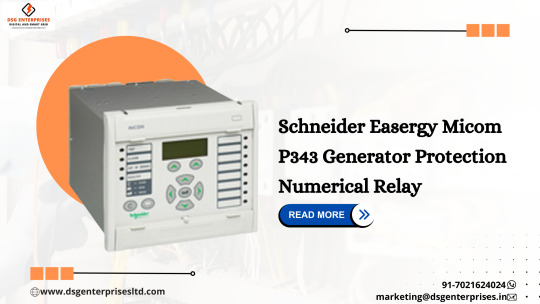#generatorprotection
Text
The Alstom Check Synchronising Relay SKE11BF8042BCH is an electromechanical relay designed for precise and reliable synchronization of generators with the power grid. It ensures that voltage, frequency, and phase angle are accurately matched before connecting the generator to the grid, thereby preventing equipment damage and ensuring system stability. This relay, with its robust design and advanced control features, is ideal for industrial and utility applications where dependable synchronization is essential. It operates on a 110/125V DC auxiliary voltage, with adjustable voltage settings and a time delay feature, making it a versatile and essential component in power protection systems.
𝐂𝐨𝐧𝐭𝐚𝐜𝐭 𝐮𝐬 𝐨𝐧 +91 7021624024 𝐨𝐫 𝐠𝐞𝐭 𝐢𝐧 𝐭𝐨𝐮𝐜𝐡 𝐰𝐢𝐭𝐡 𝐮𝐬 𝐚𝐭 [email protected].
#alstom#alstomrelay#synchronisingrelay#ske11bf8042bch#powergrid#generatorprotection#electricalsafety#powersystem#voltagemonitoring#frequencycontrol#phaseangle#industrialautomation#utilityequipment#powersynchronization#gridstability#electricalengineering#relaytechnology#smartgrid#power protection systems
0 notes
Text

#alstom#MicomP343#protection#generatorprotection#relay#electricpower#electricalsafety#powergrid#powersystem#powerplant#energymanagement#powerdistribution#gridstability#gridreliability#electricalengineering
0 notes
Video
youtube
What Happens If You Connect a Capacitor to a Generator? | Electrical Tips
#ElectricalEngineering #GeneratorSafety #CapacitorConnection #PowerFactor #AlternatorTips #ElectricalConcepts #PowerFactorCorrection #EngineeringTips #GeneratorProtection #ElectricalBasics #Capacitor
0 notes
Text
Finding the Perfect Fit: Choosing the Most Suitable Relays for Different Power Grid Applications
In power grids, relays play a crucial role in protecting electrical systems from faults and ensuring their reliable and safe operation. However, selecting the right relays for specific applications can be a complex task. In this post, we will explore key factors to consider and provide guidance for choosing the most suitable relays based on specific power grid applications.
1. Overcurrent Protection:
Overcurrent events can occur due to various reasons, like short circuits or equipment malfunctions. To protect against these events, overcurrent relays are essential. When selecting overcurrent relays, consider the expected load current magnitude, fault current levels, and coordination with upstream and downstream protective devices.
2. Distance Protection:
Distance relays are used to protect transmission lines by measuring the impedance between the relay location and the fault location. Factors to consider when selecting distance relays include fault location accuracy, fault resistance detection capability, and speed of operation.
3. Differential Protection:
Differential relays compare current inputs on both sides of a protective zone to detect internal faults within transformers, generators, or busbars. Considerations when choosing differential relays include sensitivity requirements, operating characteristics (adaptive or fixed), and communication capabilities.
4. Generator Protection:
Generators are critical components of power grids, and protecting them from faults is essential. When choosing relays for generator protection, parameters such as stator winding faults, rotor faults, loss of excitation, and loss of synchronization must be taken into account.
5. Transformer Protection:
Transformers are vital for voltage conversion and supply stability. Transformer protection relies on various aspects such as overcurrent protection, differential protection, backup protection schemes, and thermal protection to safeguard against faults.
6. Motor Protection:
Motors are key elements that drive industrial processes, and their protection is critical for uninterrupted operations. Motor protection relays should consider factors like overload protection, phase asymmetry, locked rotor detection, and thermal model-based protection.
Conclusion:
Selecting the most suitable relays for specific power grid applications requires careful analysis of various aspects, including fault types, system topology, coordination requirements, and desired response times. It is essential to consult with experts, refer to industry standards, and leverage the experience of relay manufacturers to ensure the optimal selection for a reliable and effective protection scheme. By considering these factors, power grid operators can enhance the safety and stability of their systems.
Remember, every power grid is unique, so it's crucial to tailor the selection of relays to the specific needs and characteristics of your own system.
#PowerGrid #RelaySelection #ElectricalProtection #OvercurrentProtection #DistanceProtection #DifferentialProtection #GeneratorProtection #TransformerProtection #MotorProtection #FaultDetection
0 notes
Video
youtube
Differential Protection Of Generator | Generator Protection in Hindi
0 notes
Text
The Alstom Check Synchronising Relay SKE11BF8005BCH is a specialized device used in electrical power systems to ensure safe and accurate synchronization between generators and the power grid. This relay monitors and compares the voltage, frequency, and phase angle of the generator and the grid before allowing connection, preventing damage to the equipment and maintaining system stability. It features robust design and precise control mechanisms, making it suitable for a variety of industrial and utility applications where reliable power system synchronization is critical.
C𝐨𝐧𝐭𝐚𝐜𝐭 𝐮𝐬 𝐨𝐧 +91 7021624024 𝐨𝐫 𝐠𝐞𝐭 𝐢𝐧 𝐭𝐨𝐮𝐜𝐡 𝐰𝐢𝐭𝐡 𝐮𝐬 𝐚𝐭 [email protected]
#alstom#synchronisingrelay#ske11bf8005bch#powergrid#generatorprotection#electricalsafety#powersystem#voltagemonitoring#frequencycontrol#phaseangle#industrialautomation#utilityequipment#powersynchronization#gridstability#electricalengineering
0 notes
Text

The Schneider Easergy MiCOM P343 generator protection relay ensures seamless integration of protection, control, monitoring, and measurement capabilities for generators of all sizes. Within the Easergy MiCOM P34x product line, a diverse range of functions provides comprehensive protection and control. This adaptability translates into cost-efficient solutions suitable for a wide array of applications.
C𝐨𝐧𝐭𝐚𝐜𝐭 𝐮𝐬 𝐨𝐧 +91 7021624024 𝐨𝐫 𝐠𝐞𝐭 𝐢𝐧 𝐭𝐨𝐮𝐜𝐡 𝐰𝐢𝐭𝐡 𝐮𝐬 𝐚𝐭 [email protected]
#schneidereasergy#micomp343#generatorprotection#numericalrelay#electricalsafety#powergeneration#relaytechnology#energymanagement#industrialcontrol#electricalengineering#gridprotection#smartgrid#renewableenergy#automation#powergrid
0 notes
Text
The Schneider Easergy MiCOM P343 generator protection relay offers versatile and dependable integration of protection, control, monitoring, and measurement functions for generators of various sizes, including small, medium, and large.
#easergymicomp343#generatorprotection#numericalrelay#schneiderelectric#relaytechnology#smartgridsolutions#gridsecurity#electricalengineering#energymanagement#gridreliability
0 notes